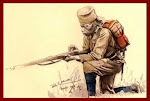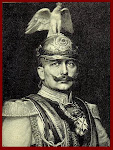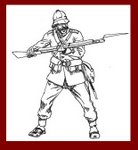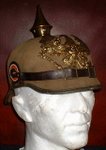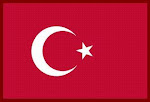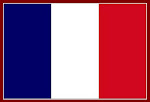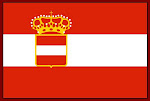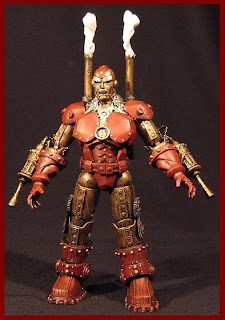
Friday, February 29, 2008
Thursday, February 28, 2008
Hill Village
WWI Inventions
Timewatch: WWI Tanks
occasional history series 'Timewatch', examines the impact of the
use of tanks by the British during the Great War. Anyone hoping
for a technical, or even detailed tactical, history will be disappointed.
Rather, the program looks at claims that the tank was a war-winner,
and looks at its effect on morale, especially Allied morale.
Whether or not you agree with the program's thesis, the wealth of
movie footage is wonderful to see, and the Tank Museum at
Bovington even gets one of its surviving Mk IVs out for a spin!
There are interesting guest talking heads, such as Brian Wilson,
son of Walter Wilson, one of the co-designers of the first British
tanks, and David Fletcher, of the Bovington Tank Museum, surely
one of the greatest living experts on early tanks.
Saturday, February 23, 2008
Redcoat Tribute
The Martian Chronicles

Synopsis
"Based on Ray Bradbury's sweeping sci-fi classic, this 1979 mini-series details the mystery, wonder and horror of humankind's attempts to leave Earth and establish a new culture on Mars. Scientists travel to Mars to study its atmosphere and terrain, and decide that earthlings can dwell safely in this new environment - but some in the group learn that an alien life form might exist beneath the planet's surface. Everyone will eventually learn that the colonization of Mars might not be welcomed by its present inhabitants... and with good reason. This epic television production originally aired in three parts."
Or read a preview of the book here:
Mars:A Different Look at the Red Planet

by James L. Cambias
Artwork and Maps by Bob Brown
The following article describes a variant Mars for use with Space: 1889, Castle Falkenstein or other Victorian-era roleplaying games. Some of the concepts presented are adopted from the original Space: 1889 background, others are new. Gamemasters can use this version of Mars in place of the planet presented in Space: 1889, or use the ideas here to supplement the original game.
The geography and physical details of the planet are drawn closely from Mars as it actually exists, although for this article the mass and density have been increased, and an Earthlike atmosphere added.
The Planet
Mars Map One: JPEG File Size 184k - Mars Map Two: JPEG File Size 217k
Mars is the fourth planet from the Sun. It orbits the Sun at a distance of 142 million miles, and has a year 686 days in length, or nearly two Terran years. Mars rotates on its axis once every 24.5 hours, so that its day is almost exactly the same as the Earth's.
Its diameter is 4200 miles -- about half that of the Earth. Mars (in this universe) is as dense as the Earth is, giving it a surface gravity equal to one-half that of the Earth. This lower gravity makes Martians taller and physically weaker than Terrans.
The atmosphere of Mars is composed of 55 percent nitrogen, 38 percent oxygen, 5 percent carbon dioxide and 2 percent trace elements. Atmospheric pressure in the lowlands is 500 millibars; Terrans can breathe there with no difficulty. In the uplands it is only 350 millibars, and Earthmen must spend several weeks getting accustomed to the thin air. Both air and heat are retained by the mysterious Sky-Shield generators, located on Phobos, the inner moon.
The Terrain
Two-thirds of the planet's surface are uplands. Most of the southern hemisphere is occupied by the high country. Less than an eighth of the Martian population lives in the uplands. The upland terrain consists of mountains, badlands and enormous stretches of desert. The highest portion of the uplands is the Tharsis Plateau, where the four great volcanoes Olympus, Pavonis, Arsia and Ascraeus rise twenty miles above the old sea level. Beneath the uplands are vast networks of caverns, carved by water as the sea levels dropped. Only near the seabeds are there areas of steppe. Irrigated regions along the canals contrast sharply with the sandy wastes beyond.
The lowlands are the old sea-beds, and are more fertile. Concentrated in the northern hemisphere, they hold most of the planet's population. Most of the land is prairie, with patches of forest. The deepest parts of the seas are now great swamps, and two large lakes remain, a dwindling memory of the lost oceans.
Canals: The most spectacular engineering work in the Solar System is the impressive network of canals bringing water from the polar regions to the thirsty cities of Mars. The canals were built in two stages. As drought first began to affect the planet, canals were built to irrigate the continents and fight the encroachments of desert. The remnants of this system forms the upland canal network. A million years later, when the oceans had become mere puddles, a second canal system was built to irrigate the lowlands. In the Marineris and Kasei valleys, the canals feed into existing river systems. Elsewhere the canals have replaced the rivers completely.
History of Mars
Mars formed millions of years before the Earth did, and intelligent life arose there nearly ten million years ago. Though much has been lost, it is possible to reconstruct a rough timeline of Martian history, from the days of the first intelligent beings.
c. 10 million BC: Evolution of the gold-skinned First Martians.
c. 8.5 million BC: Peak of First Martian civilization.
c. 8.2 million BC: First Martian civilization collapses due to unknown causes.
c. 7 million BC: Survivors of First Martians evolve into the Second and Third Martians -- the modern Namasda Sand Martians and the green-skinned Almali Upland Martians.
6.8 million BC: Rise of Third Martian civilization, centered around the Hellas Sea.
6.6 million BC: Drought begins to affect Mars.
6.5 million BC: Construction of the upland canal system, and the colossal statues of Echus Chasma and the Valles Marineris.
6.3 million BC: Planet Demeter (the fifth planet) explodes. Mars is bombarded by meteors, bringing about the collapse of civilization. The canals stop flowing, and much of the uplands goes to desert.
c. 6 million BC: Ocean levels start dropping; Martians begin settling in the lowlands and abandoning the old uplands. The Hellas Sea dries up completely.
c. 5.5 million BC: Evolution of winged Fourth Martians or Ghama from Almali mountaineers.
5.2 million BC: Restoration of Martian civilization by Almali, centered in the Valles Marineris lowlands.
5 million BC: Insect-like Mikona survivors of the Fifth Planet in suspended animation among the asteroids are revived and invade Mars. To aid them, they create the avian Kreesh as warrior slaves.
4.9 million BC: After a series of wars, Mars is completely subjugated by the Mikona. A remnant of the Third Martians retreat to the caverns under Syria.
4.7 million BC: Kreesh slaves rebel against their Mikona masters and seize control of the lowlands.
4.5 million BC: Cavern-dwelling Martians emerge from hiding and defeat the Kreesh. The lowlands are liberated, the Kreesh are driven into the uplands, and the Mikona seek refuge at the North Pole.
4.4 million BC: Peak of Martian civilization under the rule of the cave-dwellers. Great Wall around Argyre constructed.
4.2 million BC: Cave-dweller empire enters a long period of stagnation and decline.
c. 4 million BC: Drought begins to affect the lowlands. Around this time, the differences among the cavern-dwelling rulers, their lowlander subjects and the uplanders are great enough to speak of the evolution of the Fourth and Fifth Martians -- the pale Muntelna and the blue-skinned Mancala, respectively.
3.8 million BC: War of rebellion by the Mancala ends the Muntelna empire and drives them back underground.
3.7 million BC: Civilization collapses completely except in undergound enclaves and Mikona cities to the north.
3.5 million BC: Mikona create a servitor race from Martian stock, the little Sixth Martians, or Minvra.
3.2 million BC: Rise of a new Mancala civilization based in the Chryse lowlands.
2.9 million BC: Mancala construct a canal system to irrigate the lowlands, and restore many of the upland canals. Construction of the Cydonia Face.
2.6 million BC: Colossal war between two rival empires disrupts civilization; much of the upland canal system ruined.
c. 2.5 million BC: Rate of planetary drying accelerates as Mars cools and its atmosphere thins. Scientists unite the Mancala under their rule.
2 million BC: Science Lords launch the moons of Mars and construct the Sky Shield.
1.9 million BC: Science Lords plant colonies on other worlds (the Earth colony fails due to the rising sea levels after the Ice Age).
1.7 million BC: The scientific caste transform themselves into the Seventh Martians, the tentacled Tasminra.
1.5 million BC: Other races ally against Tasminra rule; they withdraw to their Citadels.
1.3 million BC: Outside of Tasminra and Mikona enclaves civilization stagnates and declines.
10,758 BC: Founding of the Empire of Acidalia by the God-Emperor Sandaar I.
1876: Terrans arrive
Races of Mars
Mars has a total population of about 200 million sentients. They are divided into nine different major races. The proportions of the various races are as follows:
86 million Mancala (Lowland Martians) -- 48%
48 million Minvra (Lesser Martians) -- 24%
20 million Almali (Highland Martians) -- 10%
12 million Muntelna (Cave Martians) -- 6%
10 million Kreesh -- 5%
6 million Ghama (Sky Martians) -- 3%
4 million Mikona (2%)
2 million Namasda (1%)
2 million Tasminra (1%)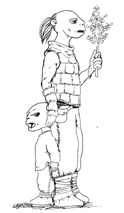
Mancala (Lowland Martians): The most numerous race on Mars are the blue-skinned Mancala. They live along the canals in the lowlands, and in some upland cities, farming and trading. Many serve the Tasminra or the Mikora. Often at the mercy of more warlike beings, the Mancala survive by patient fertility and preindustrial technology roughly equal to that of Earth in 1600. Mancala can interbreed with Almali and Muntelna.
Mancala are tall, barrel-chested humanoids. The men stand between six and seven feet tall, the women a trifle shorter. They have six fingers on each hand, like most Martians. Their skin ranges from pale blue-white to a bright sky-blue. Hair is scanty, usually deep black. Very rarely a Manca will be born with metallic gold hair.
Mancala are long-lived by human standards, with an average adult lifespan of about fifty Martian years, or more than a Terran century. A few individuals have lived nearly twice that span naturally, and there are accounts of others using artificial means to live for millennia.
Minvra (Lesser Martians): An artificial subspecies, the Minvra were created as servitors by the Mikona. They are shorter than any other kind of Martian, standing only four feet tall. Their childlike bodies are weak and frail. Nevertheless, the Minvra are often grandiose and egotistical. They are the second most numerous race on Mars, living almost entirely in the lowland cities or the polar Mikona enclaves. Despite their numbers they are everywhere subjects of others.
Minvra have black skin -- not the dark brown an Earthman would call "black," but a true charcoal black, sometimes with traces of blue or green. Their eyes are large and white. Minvra are short-lived by Martian standards, with an average lifespan about the same as that of a human from Earth.
Minvra have much the same technology as the Mancala. Many claim to be privy to the scientific secrets of the Mikora, but those who actually do get technical training spend their lives within the polar cities.
Almali (Highland Martians): Almost identical to the ancestral Third Martians, the green-skinned Almali are the hardiest and most handsome of the true Martian stock. They dwell in the steppes and deserts of the uplands, herding and gathering in the wilderness. They leave the sandy deserts to the Namasda. Kreesh and Almali are deadly enemies in some regions, while elsewhere they form extended biracial tribes. Almali have a technology roughly equivalent to that of Iron Age Europe. They can interbreed with Mancala.
Almali have green skin, roughly the color of olives. Those who spend a lot of time outdoors take on a yellower tinge. Their hair is black or reddish-brown. Their most striking feature is their eyes, which develop a silvery film after a few years spent in the desert sun. Like the Mancala, the Almali live long lives, up to a Terran century if disease or violence do not intervene.
Almali men are the tallest on Mars, sometimes standing eight feet in height. Their women are as big as the men. In some Almali tribes, the women live in seclusion, completely subject to their husbands. Other bands are matriarchies, and there is a large and powerful tribe of amazons.
Though they make up only a tenth of the population, the Almali control half of the planet's surface. Their war-bands are mobile, and every adult Almal is a warrior. Perhaps once in a millennium a warlord will unite most of the upland tribes into an unstoppable army, and conquer vast tracts of the planet. Consequently many lowland cities are ruled by a green-skinned aristocracy.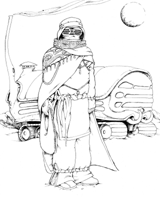
Muntelna (Cave Martians): The Muntelna are the inhabitants of Mars's extensive system of caverns and tunnels. They were driven underground during the Mikona invasion and have become adapted to their subterranean existence. At one time the Muntelna were the rulers of the surface world, but have since degenerated. They have the most advanced technology save for the Tasminra and Mikona. Their machines are slightly more advanced than current Terran designs, but the Muntelna do not really understand how any of it works. They can interbreed with Mancala.
Muntelna dislike leaving their comfortable caverns. When they do they are careful to cover themselves up in hooded cloaks, and prefer to venture forth at night. On the rare occasions they must be out in daylight they wrap themselves completely in cloths and wear heavy goggles.
Muntelna have very pale green skin, and large all-black eyes. Their hair is either black or silver, and both sexes begin going bald at puberty. Muntelna do not naturally live as long as their cousins on the surface; thirty to forty Martian years is the normal span. The Cave Martians extend this by means of glandular extracts taken from slaves and criminals, so their ruling class often live to a hundred.
They are tall and gaunt, and usually have a pronounced stoop. A Muntel standing erect might be seven feet tall, but the curvature of the spine reduces that to only six feet. Muntelna have large hands with long, slender fingers.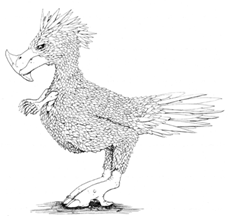
Kreesh: When the Mikora needed warriors, they took an aggressive predatory ground bird from the steppes and raised it to sentience. The Kreesh cannot fly, but run faster than a man. They have taloned hands, sharp beaks, and a bloodthirsty disposition. Kreesh have green feathers with a red crest. Kreesh sexes live separate lives -- the females maintain nest-cities in the lowlands, where they raise flocks and do a little farming. The males are nomadic traders, hunters, and warriors in the uplands. Female Kreesh have about the same technology as the Mancalaasthrin, but males live a stone-age existence.
The Kreesh once rose against their Mikona overlords, and for a time they were the masters of the lowlands. Martians have long memories, and even now Kreesh are feared and hated by the other races of Mars.
Kreesh are omnivores, but prefer to eat meat rather than vegetable food. They have no compunction about eating the flesh of other sentient species, and in some slave markets one may see Kreesh prodding the merchandise to see how meaty the poor slaves are. Kreesh do not live long -- twenty Martian years is normal, thirty is exceptional. Male Kreesh seldom live past fifteen.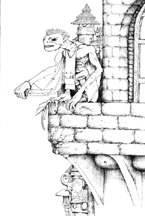
Ghama (Sky Martians): The rulers of Mars's skies are the Ghama. A true separate species descended from Almali stock, the Ghama have evolved the ability to fly, and have large wingflaps extending from arms to thighs. Ghama flight is accomplished by a combination of wings and body tissues impregnated with Cavorite by natural processes.
The Ghama are small by Martian standards -- only the Minvra are smaller. Male Ghama are no more than six feet tall, and females seldom top five feet. Their chests and arms are enormously enlarged and muscular, but their legs are short and weak. Ghama have yellow-green skin and bristly reddish hair. Their wingflaps are thin, almost translucent, and are stiffened by ribs of cartilage. Ghama live thirty to forty Martian years on average.
They once were distributed all over Mars, but now live in isolated mountain fastnesses, or else in three flying cities constructed from the antigravity metal Cavorite. Their own technology is extremely crude and primitive, and they depend on devices stolen from other cultures. Ghama culture is based on intimidation and predatory raids on surface communities.
Namasda (Sand Martians): Descended from the First Martians directly, Sand Martians live in the shifting dune seas of the upland deserts, burrowing through the sand with their heavy clawed hands. They are nearly blind, but can sense vibration miles away. The sand-dwellers maintain vast burrows under the desert, where much of Mars's past is preserved. At night they emerge to sing endless songs of the planet's history. Namasda use almost no tools or artifacts, but maintain a surprising level of scientific and technical knowledge.
They have fewer fingers than other Martians -- only three digits on each hand, fused into heavy claws that are clumsy at fine manipulation but lethal in combat. Their eyes are tiny and nearsighted. Namasda are covered all over with fine gold hair. They live enormously long lives, apparently without the use of any advanced medicine. It is common for a Namas to be still active at the age of a thousand Martian years.
Mikona (Demeterians): Survivors of the destruction of the lost Fifth Planet, the Mikona are an insectile species with metallic red shells and glowing multifaceted eyes. They can fly on great webby wings. Among themselves they communicate by ultrasonic twitters, and use artificial voice-boxes to speak with other races.
The Mikona are descended from six individuals who survived the destruction of Demeter in suspended animation inside a solid steel sphere. Their indestructible tomb drifted among the asteroids for millions of years until a meteorite tripped the waking device and the sleepers revived. They managed to reach Mars, and attempted to make it their world.
The Mikona's advanced science enabled a tiny band to conquer most of Mars, but in time they too became decadent and were overthrown. Today some remain rulers of Martian cities, while others have retreated to their refuges in the wastes of the Polar ice, where they intrigue against the Tasminra and dream of rebuilding their lost empire. Mikona have advanced technology ahead of anything on Earth, which the guard jealously. They are particularly adept at biology, and created the Minvra and the Kreesh.
Mikona live indefinite spans -- unless claimed by accident, violence or disease a Miko can theoretically survive forever. At least one of the orginal conquerers of Mars is still alive in one of the polar cities.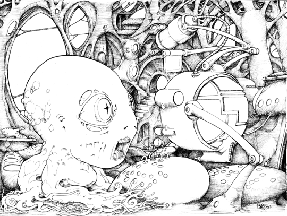
Tasminra (Great Martians): The most weird and enigmatic race on Mars are also the most powerful and advanced. The Tasminra arose from the ruling scientific elite of the Fifth Martians. They are horrible to behold -- huge pale heads with saucer-like eyes, standing atop bunches of twelve tentacles. Their skins are a grayish-green like wet leather. Having rid themselves of such crude functions as eating and digestion, they feed on the blood of their subject races, and view all others as lower forms of life. Seldom leaving their scattered citadels, they rule the planet as much as they care to, but spend most of their time in arcane contemplation and subtle power struggles.
Tasminra technology is incredible, even by Terran standards. They have the secret of making Cavorite, the antigravity metal, and still build a few airboats and skyships each year. The Tasminra constructed the fantastic Sky Shield generators on Phobos, which keep Mars from losing heat and atmosphere to space.
So far, no Terran has been able to meet the Tasminra face to face. (It is rumored that the tentacled Martians have purchased a few Earthling captives from Ghama raiders for scientific purposes.)
Technology
Mars has a fantastic mix of technology. The Namasda are the most primitive, making use of crude implements of bone, leather and chipped stone. This is odd considering their remarkable knowledge of science.
The Ghama are next up the technology scale. They (or their slaves) can work metal and make pottery. They can make gunpowder, although they lack the industrial base to forge cannon; consequently they rely heavily on rockets and firebombs. Ghama also employ a great deal of stolen equipment, and have some impressive relics of the past, including the flying cities themselves. Because the Tasminra do not sell them any more Cavorite hulls, the Ghama are quite good at making large balloons and dirigibles out of animal hides, filled with hot air.
The Almali are slightly more advanced than the Ghama, or perhaps can simply afford more complex facilities. They weave cloth, work iron, and make ceramics. They use guns and bows, and sometimes make rockets. Almali trade more with the lowlanders, but have almost no relic superscience.
Kreesh have a split technology. Females are as advanced as the Almali or possibly more so. They weave, do fine metalwork and are adept at brewing and distilling. But male Kreesh are primitive nomads, carrying only those tools they make themselves out of stone and bone.
The Mancala are generally at a preindustrial level of technology. They make cloth, metal, ceramics and glass. They make gunpowder and distilled liquors, and make extensive use of water and wind power. Their artisans can construct some complex machinery. As builders and agriculturalists they are unequaled. Mancala make most of the guns and technological devices used by the Almali and Ghama.
The Muntelna are as advanced or more so than Victorian Earthmen, but they no longer manufacture many items and it is thought they no longer know how. They have elaborate clockwork machines and automata, digging machines and lumbering land vehicles, and delicate ornithopters. Muntelna prefer to use flame-guns rather than firearms, because they are more effective underground. They are also experts at chemistry, and make use of poison sprays, gas-bombs and lethal darts.
At the top of the Martian technology scale are the Mikona and Tasminra. It is not clear which are more advanced. Both have Cavorite antigravity metal, radium power, interplanetary flight, and fantastic machines. The Mikona do not depend on their machinery as much as the Tasminra, but that doesn't mean they aren't as advanced. It seems that the Mikona are marginally better at biological engineering, while the Tasminra seem to have an edge with physical technology. These may simply reflect preferences rather than capacities.
Some devices unique to Martian technology include: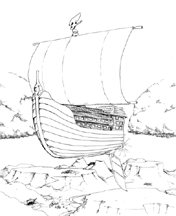
Flying Ships: All flying ships have hulls made of the fantastic antigravity metal Cavorite, whose manufacture is still a secret of the Tasminra. Cavorite hulls can last for centuries, so despite the fact that the Tasminra produce only a few airships every year, there are some 7000 vessels in the skies over Mars.
There are exactly six types of Cavorite hull. The smallest is the 2-ton Breezeboat, used for couriers and pleasure craft. Next is the 8-ton Aircutter, often employed as a scout. The 30-ton Windsloop is often found in the hands of small traders or pirates. The 160-ton Stormbark is very common as both a merchant and a warship. The 500-ton Cloudclipper is the backbone of most fleets, and the huge 2000-ton Skygalleons are found serving only the richest cities.
A few hybrid craft exist. The Sky Martians in particular are fond of combining several hulls to make large flying catamarans or trimarans. Only they have been able to keep such ships stable; experiments by ground-dwelling Martians always end in disaster. The Muntelna and some advanced Mancala have tried to supplement the lifting power of Cavorite by adding balloons or vertical airscrews. The problem is that hydrogen balloons are very vulnerable to Heat-Ray and fire-spray attacks, while airscrews need a constant reliable power source.
Methods of propulsion vary. New ships from the Tasminra yards are driven by airscrews powered by radium engines. The radium power source lasts 20 years before running down. What to replace it with is entirely up to the owner -- some put on masts and sails, others construct crude clockwork or manpowered machines. A few use steam engines manufactured by the Muntelna.
New flying ships are generally armed with a single Heat-Ray projector. The Heat-Ray is an enormous drain on the radium power supply, so shipowners like to supplement the Ray with cannon, batteries of rockets, fire-sprays and rams.
In Space: 1889 terms, assume Cavorite hulls have an armor value of 2 -- but damage to Cavorite hulls cannot be repaired. The radium engines weigh 1/50 of the ship's capacity (minimum of 1 ton), and have enough power to give a speed of 6. The two exceptions are the Breezeboat, which has a top speed of 12, and the Aircutter, with a top speed of 9.
Heat-Rays: The terrible Martian Heat-Ray is the ultimate weapon of the Tasminra. They occasionally give or sell them to the other races, and they are prized weapons in a city's arsenal. A Heat-Ray projects a beam of intense heat with a range of half a mile. It melts metal, burns wood, cracks and shatters brick or stone, and chars men to ashes. But a Heat-Ray has certain limitations -- while its radium power supply is good for years of use, the Ray must recharge briefly after each shot. It cannot simply be swept over an army like a searchlight.
Reflective metal can also block the Heat-Ray, at least at long range. Martian soldiers carry large, mirror-surfaced aluminium shields (with an inner layer of ceramic). At long range, soldiers properly shielded can withstand a Heat-Ray shot -- although the blast does make their shields extremely hot and a second hit would certainly melt them. In close quarters nothing can withstand the Heat-Ray's power.
Fortunately, they are quite rare. Cities have (1 die-4) Heat-Ray projectors available in addition to those mounted aboard ships in the navy. A projector weighs 1 ton, and must either be connected to a flyer's radium engine or else have a power unit weighing another ton. Obviously, in battle an enemy's Heat-Ray projector is a prime target, so most cities keep them as a last-ditch defense on the city walls.
In Space: 1889 terms, the Heat-Ray has a short range of 4 hexes (long range of 8). It has a Penetration of 4 at short range, 2 at long. Damage value is 4 at short range, 2 at long. Subtract the armor value from the damage done when penetrating armor. In Castle Falkenstein terms, the Heat-Ray does Horrible damage.
Catapults: A shortage of metal on Mars has made many Martian armies rely on catapults instead of cannon. Highly sophisticated designs make Martian ballistae very effective, with a range of up to a quarter of a mile. The Martians load their ballistae with a variety of projectiles, including explosives, fire-bombs, poison-bombs, smoke-bombs and occasional solid shot.
Catapults in Space: 1889 have a short range of 1 hex and a maximum range of 2. They have a crew of 4 and fire every other turn. Explosive shells have a DV of 3 but no Penetration. Fire-bombs act like Liquid Fire, poison-bombs have a DV of 4 but only affect crew, and solid shot has a DV of 2, penetration of 1.
Governments
Mars has no single government, except when it does. In general, the various tribes and petty states are completely sovereign, and acknowledge no superiors. But from time to time the Tasminra will issue directives, and all Martians (possibly excepting the Mikona) obey them.
It is not known if the Tasminra have any unified government of their own. Individual citadels (or possibly just individual Tasmin) may simply order the lesser races about without consulting the others.
The rest of the planet is a patchwork of states, just like the Earth. Most of the lowland cities are rich and populous enough to maintain their independence. Large stretches of the uplands are loosely controlled by tribal warlords.
The basic unit of government in the lowlands of Mars is the city. Martian cities range from only ten thousand to nearly a million. They have a wide variety of governments -- see the section below on cities. In the uplands, tribes are the most important type of government. The section on tribes below gives details of their organization.
Important States
At present, there are six states on Mars which qualify as that world's Great Powers. They are: The Empire of Acidalia, the League of Free Cities, the Kingdom of Isidis, the Underground Empire, the Republic of Melas, and the Khanate of Noachis.
Acidalia: Acidalia controls the rich and fertile region south of the great Acidalia Bog, extending as far west as Tractus, eastward to the Cydonia hills, and south to the Chryse morass. It is ruled by God-Emperor Dateeris from the capital city of Acidalia. The Empire's population is five million, mostly Mancala and Minvra. Acidalia controls six major cities and some of the best agricultural land on Mars.
The Empire's economy is mostly based on farming. Though there are mines at the edge of the Tempe and Cydonia uplands, Acidalia has no industry of its own, and must import tools and weapons from the manufacturing centers at Tantalus and Mamers.
Acidalia has a very large but inefficiently run army of 22 legions, none at more than a quarter of full strength. The Empire has a formidable navy of canal barges to patrol the Acidalia Bog and fight pirate incursions. There are 18 ships in all, including three large war galleys. The Imperial air navy is good-sized, with 16 ships mostly in the middle hull sizes, including a sail Skygalleon and a clockwork Cloudclipper. One Windsloop and one Stormbark are new, and carry Heat-Rays.
The Free Cities: The League of Free Cities is an aggressive alliance of trading cities in the Elysium and Amazonis lowlands. There are four cities in the League -- Eumenides, Elysium, Apollinaris Patera, and Cerberus. Together they dominate most of the other city-states in the region, and control a region boasting 4 million inhabitants.
Cerberus and Eumenides are the chief industrial cities of the League, while Elysium is a trading and financial center and Apollinaris Patera is a rich agricultural town. The League controls the canal trade south to Icaria, and the caravan routes across Eridania. Each city has its own government and is strictly sovereign about internal affairs. Apollinaris Patera is ruled by a strong but decadent Prince who is happy to leave foreign policy to the League. Cerberus is a participatory republic. Elysium is a republic dominated by the rich, and Eumenides is a republic under the control of a popular demagogue.
The combined army of the League is small, only 6800 men in 8 half-strength legions. The canal navy is not large, but its 8 galleys are all large and well-constructed warships. The Free Cities do have one of the most powerful aerial fleets on Mars, with a total of twenty ships, including 4 great Skygalleons. Three of the ships -- a Breezeboat, a Stormbark and a Cloudclipper -- still have radium engines and Heat-Ray projectors.
Isidis: The Kingdom of Isidis is a new and growing rival to the power of the Free Cities. Ruled by a dynasty of mixed Mancala and Almali blood, the Kingdom controls the Isidis basin and vast tracts of the Syrtis Major uplands. Blood ties and commercial treaties with the steppe tribes have extended Isidian influence to the south, giving it control of the overland trade with Hellas and the Mare Australis. The Kingdom includes the cities of Isidis and Syrtis Major, and has a total population of two and a half million.
The Isidian economy is based on trade, ranching and herding in the uplands, and the mines of the Nilosyrtis hills to the north. King Reethag is desperately trying to modernize his realm and encourage industry, but as yet Isidis still imports most manufactures.
Isidis has a powerful army of 17,000 men in 10 full-strength legions, and a modest canal navy of 7 war barges. The Isidian aerial force is relatively weak, with only 6 vessels, all small and old, used mostly for reconaissance and scouting.
The Underground Empire: The Underground Empire is the last remnant of the dominions of the Muntelna. It comprises the Noctis Labyrinthus and extends deep under Syria and Sinai to the subterranean Last Sea. The Muntelna are xenophobic and isolationist, but their territory borders the rich Coprates Rift and controls the trade routes around Tharsis. Six million Cave Martians and a million Minvra and Mancala slaves live in the caverns of the Empire. The Underground Empire is governed by a Regency Council on behalf of the extinct dynasty of Dark Emperors. The Council is made up of the leaders of important families, companies and guilds, and exercises power through a bureaucracy of slaves and a network of spies and secret police.
The Cave Martians manufacture guns and machinery for export, raise fungi, and catch blind fish in the Last Sea. The Underground Empire imports agricultural goods from the Valles Marineris, and does a good trade with the Sky Martians of Tharsis for slaves.
For defense, the Underground Empire relies on an army of 25,400 men organized into 16 legions. The Empire has no water or aerial navy, but it does maintain a mechanized force of a hundred steam-driven Mole Tanks, and an armada of 36 giant Steam Castles.
Melas: The Republic of Melas is the richest and most powerful of the Valles Marineris city-states, and is the unofficial leader of the region. It includes the cities of Melas and Ius, along with some thirty smaller towns and a total population of 6 million. Melas controls some very rich farmland, and sits astride the trade routes following the Marineris River. Ius boasts a small manufacturing base, producing textiles and some metals.
The Republic has an army of five Legions, each with about 1500 men. The army includes two cannon batteries with 8 guns each, two rocket batteries with 6 launchers each, and one catapult battery with 10 mangonels. Melas's water navy has 14 war barges which control the Marineris River in the central part of the valley. The Republic's aerial navy boasts 15 ships, three of which still have their radium engines and Heat-Ray projectors. The flagship is a brand-new radium-powered Skygalleon.
Cities
The Mancala have an extensive urban culture. In the lowlands, the population density along the canals is about 100 per square mile, occupying a belt of irrigated land several miles deep (usually about 25 miles on either side of the canal). Beyond the irrigated zone are expanses of steppe, where herds graze and the population density is equivalent to that of the uplands. The canals and a few surviving river systems cover some 28,000 miles in the old seabeds. There is usually a village every 5 miles or so along the canal, with a couple of hundred people. Larger towns with a population of about a thousand are spaced about 50 miles apart. Cities with tens of thousands of inhabitants are at intervals of some 500 miles. A handful of great metropoli have populations in the hundreds of thousands, and the giant city of Ophir rivals the capitals of Europe in size.
City Generation: To determine the size of a city, roll 2 dice. On a roll of 10 or less the city has a population of 10,000 times the die roll. On an eleven or twelve, reroll the dice and multiply the result by 50,000. Cities usually control a hinterland with a population ten times that of the city itself. This territory usually includes towns in the 1-10,000 range with a total population equal to the capital city.
Most cities have one predominant race. Roll 2 dice and multiply by 10 for the percentage of the population belonging to the majority race; these will always be either Upland or Lowland Martians, depending on where the city is located. If the result is less than 70 percent, roll a second time and multiply by 5 to determine the percentage of a second race. Roll on the table below to determine the minority. In all cases the remainder are a mix of other races.
Ethnic Makeup Table: Roll 1D6 for minority races (add 1 in the lowlands):
1: Winged Martians
2: Kreesh
3: Tunnel Martians
4-5: Uplanders/Lowlanders (whichever is not the majority)
6-7: Minvra
Government: Martian cities have a variety of government types. Many are controlled by powerful outsiders. Roll on the following table to determine who controls the city.
Control Table: Roll 1D6 for control of the city (add 1 in the lowlands)
1: Sky Martians
2: Mikona (only in the north or uplands; otherwise Free City)
3-4: Free City
5: Tasminra (roll for government as if a free city)
6-7: Empire (subject to a neighboring state)
Free Cities and cities ruled by the Tasminra have their own governments. Roll on the tables below to determine what form that government takes and how much authority it has.
Government Table: Roll 1D6
1-3: Prince
4: Republic
5: Theocracy
6: Other (make something up or reroll)
Government Strength Table: Roll 1D6
1-3: Strong (see Character)
4-6: Weak (see Influences)
Strong governments have a predominant character. There are two tables here, one for monarchies and theocracies, the other for republics. Roll on the appropriate table to determine the government's character.
Character of Strong Princes/Theocrats Table: Roll 1D6
1: Despotic
2-3: Decadent
4: Ambitious/Fanatical
5: Benevolent
6: Councilor (roll again for Councilor's character, ignoring Decadent)
Character of Strong Republics Table: Roll 1D6
1: Aristocratic (a select class controls the government)
2: Oligarchic (ruling class exists only to preserve its own power)
3: Dictatorship (an individual or small group rules with popular support)
4: Plutocratic (government is dominated by commercial interests)
5: Democratic
6: Participatory (all decisions voted by the citizens themselves)
Influences: Weak governments are subject to outside influences; these influences are the actual rulers. Roll twice to determine influences on a weak government -- the first influence is the most important, but the second is also strong and keeps the first from totally taking over. When the roll is the same, it means two factions of the same type.
Influences on Weak Princes/Theocracies Table: Roll 1D6
1: Foreign (a neighboring state or great power)
2: Priests (Mob in a Theocracy)
3: Nobles
4: Merchants
5: Bureaucracy
6: Army
Influences on Weak Republics Table: Roll 1D6
1: Foreign
2: Priests
3: Merchants
4: Army
5: Demagogue (a popular leader is in the process of taking over -- once he has complete control this will be a Strong Dictatorship)
6: Mob Rule
Economics: All cities are centers of trade and manufacturing. The local specialties depend heavily on where the city is located. Upland cities tend to be devoted to mining, metalworking, meatpacking and the caravan trade. Lowland cities make textiles and glassware, trade grain and spices, and are canal ports.
Determine a city's wealth on the following table. Poor cities have a per capita income of about 7 gold ducats per year. In average cities the income is about 10 ducats per Martian year, and in rich cities the per capita income is 15 ducats per year. The tax rate is usually about 20 percent. Hinterland towns are automatically poor, and the rural peasants generate about half a ducat per person per year.
Wealth Table: Roll 1D6 (subtract 1 in the uplands):
1-2: Poor
3-4: Average
5-6: Rich
Military Forces: It costs about 200 ducats to train, pay, feed and equip a soldier for a Martian year (including administrative overhead and so forth). Divide the government revenue by 200 to see how many soldiers a city can afford to keep up. Thrifty or peaceful states may have smaller armies, in order to save money for emergencies. Only republics can have larger armies -- a Dictatorship, Democratic or Participatory republic can field volunteer forces equal to 1 percent of the city's population. This is in addition to the professional soldiers paid out of tax revenues.
Armies are organized in legions. A full-strength legion has 12 companies, each with 144 men, for a total complement of 1728 soldiers. In actual practice, few legions are at maximum strength, and most have between 200 and 1500 troops. Cities generally have one artillery battery (cannon, rockets, or catapults) per legion. A battery can have anywhere from one to twelve weapons.
Navies: There are two types of naval forces -- canal and aerial. Canal boats are cheap, and civilian vessels can be readily pressed into military service. Aerial vessels are rare and expensive, usually acquired only as a gift from the Tasminra.
Roll two dice to determine the percentage of a city's military strength involved in the canal navy. War barges have crews of 50 to 200 men (mostly rowers). Richer cities can afford large custom-build warships with bigger crews. So if a city has, say, seventy thousand people and a standing army of 700 men, it is likely to have only one small galley in its navy.
The number of airships is equal to the city's urban population divided by 10,000, divided by one die result (round down). Airships have crews of 20 to 200 men, depending on size and method of propulsion. City rulers always make sure their airships are fully manned, even if it means reducing the army to a handful. Roll a die for each ship to see what its hull type is, and roll again to see how old it is -- on a roll of 1 the ship is new and still has its radium engines and Heat-Ray projector. Otherwise it is an old hull fitted with cannon and sails or turncranks.
Great Cities of Mars
Aureum: The largest and richest of the lowland cities, Aureum has a population of 300,000 and controls a fertile basin with four million inhabitants. It is famed for the gilded domes of its buildings and the spectacular fountains that grace every plaza. Aureum is a magnet for artists, scholars and philosophers. It would undoubtedly be a great power but for the weakness and corruption of its government. The Republic of Aureum has been ruled for millennia by the aristocrats who control most of the land around the city. Clever manipulation by envoys from Gangis, Eos and Chryse has left Aureum a virtual colony of those cities. Each foreign government has its faction in the Senate, and the only thing which has preserved Aureum's independence is that the three foreign powers don't want such a rich prize to fall to their rivals.
Chryse: A wealthy city at the south end of the Chryse Morass, this is also the center of Terran activity on Mars. Chryse has 100,000 inhabitants, and sits amid lush farmland. It is built at the mouth of the Marineris River, making it a vital trade nexus. The city is governed by Prince Fendrisht, a jolly monarch who is deeply in debt to the city's merchant community. Consequently Chryse is effectively ruled by the merchants. After some initial hesitation, the financial lords of Chryse decided that trade with Earth would be a good thing, and made their city open to alien settlement.
Chryse is located on a crescent-shaped island at the mouth of the Marineris River, with a splendid artificial harbor inside the horns of the crescent. A long causeway connects it with the shore. The city's buildings are covered in green tile, and some fanciful Terran writers have called it "The Martian Atlantis."
Because of its impregnable position, Chryse doesn't need a strong military. Chryse's army consists of a single legion of 1600 men. The bulk of the legion is run on traditional lines, armed with bows and muskets. But one company of 144 men is now equipped and trained along modern European lines. The city has only two small war barges in its navy, and an aerial fleet of 5 ships (a Breezeboat, an Aircutter, a Windsloop, and two Stormbarks). The flying ships are all man-powered and armed with rockets.
Kasei: Strategically located at the narrow mouth of the Kasei valley, Kasei is a small city that has dared to stand up to the giant Empire of Acidalia -- and win. Kasei has only 50,000 inhabitants, although its valley is home to more than a million. The city's economy is based on farming and mining, but it is not a major industrial center. It is built on the top of a giant dam that spans the mouth of Kasei Vallis, which was once part of a system to keep the waters of the Kasei River for irrigation.
Twice during the past hundred years, Acidalia has sent troops to beseige Kasei, and twice the city has resisted. The most recent Seige of Kasei, in 1846, lasted two Martian years. Kasei has been fortunate to be governed by the Th'Treenith dynasty for the past couple of centuries. While the Th'Treenith rulers have been amiable and charismatic, they have a real gift for picking geniuses as ministers. The de facto ruler of Kasei is the formidable Vizier Icheeluri, whose careful economy and shrewd diplomacy have made Kasei more powerful than its mere size could warrant.
Eos: Located at the mouth of the Marineris valley, Eos is the Sacred City for many Martians. Four of the planet's great religions were born in Eos, and the city has more than three thousand temples. By far the most impressive is the Temple of the Celestial Fire, with its hundred-foot dome of cut crystal blocks. Eos has a population of 250,000, and controls a fertile basin with 2 million inhabitants. Its economy is based on farming, trade, and pilgrimage. Each year close to a million people visit Eos, to pray at the temples, purify themselves in the waters of the Marineris River, and prepare for burial in the catacombs of Erythraeum. Eos is ruled by a Supreme Synod of priests, but the real power is in the hands of the city's bureaucracy of monks and eunuchs.
Icaria: The greatest city in the southern uplands, Icaria boasts 90,000 people within its walls, and dominates the tribes of Sirenum and the Icaria desert. It controls the only active canal linking the northern lowlands with the Mare Australis, and is a very important nexus for trade and commerce of all kinds. The city itself is covered by a large dome of glass and steel, for protection against sandstorms and marauding Ghama. At the center of the dome is a smaller dome, covering the residence of Icaria's ruler, the Priest-Khan Zagrobul. Zagrubul, like most of the ruling class, is of pure Upland Martian descent. His tribe conquered Icaria nine hundred years ago, and the tribal Khans assumed the title of the ruling High Priests. Icaria is home to a substantial population of Kreesh, who make up the bulk of the city's army.
Olympia: Olympia is a prosperous upland city on the lower slopes of Olympus Mons. Ancient mines nearby produce copper and silver, and the canal route from the south brings a steady flow of trade. Olympia has 150,000 people, a mix of Mancala, Almali and Minvra. But the rulers are all Sky Martians, who jealously keep their bloodlines pure by marrying only among themselves. The Sky Martian clans choose a king by ritual combat every six Martian years. The king rules the city through a corps of Overseers -- mostly tough Upland mercenaries. The city itself is built on a series of terraces set on a steep cliff face.
Utopia: A rich city in the lowlands north of Isidis, Utopia has 100,000 people. Though it has a strong ruler in its despotic Prince Vularv, the city is actually controlled by the Tasminra who dwell in their citadel at the center of town. The tentacled Martians protect the city with their super-scientific devices, but demand a terrible price -- the blood of five hundred Martians every week. If the tithe had to come from the people of Utopia, the city would be empty in a couple of years, but Vularv has a powerful air fleet and a strong legion of soldiers, and mounts quarterly raids on the upland tribes to the west, the Ghama to the east, and nearby cities in the lowlands. The prisoners from these attacks go to his tentacled masters. In between wars, Vularv buys slaves in all the nearby markets.
Noteworthy Sites
While it is impossible to give a complete description of all the important places on Mars, the sites below are the Red Planet's most significant features.
Tasminra Citadels: The tentacled Tasminra dwell apart from the other races in great towering citadels of steel, glass and stone. Some of these complexes are located in or near cities of the Mancala. Others are hidden away in the middle of deserts or mountains. All are wonders of super-science. Tasminra citadels are generally inhabited by about a thousand Tasminra, and four to nine thousand of their servitors -- Mancala, Minvra and Muntelna. They are entirely self-contained, powered by radium furnaces, with deep shafts to draw up water from underground aquifers. Citadels are defended by the fearsome tripod Fighting-Machines of the Tasminra, along with fleets of airships and batteries of Heat-Rays.
The Cydonia Face: In the hills of Cydonia stands one of the most impressive and enigmatic of Mars's antiquities. A giant stone head, nearly two miles long, stares upward from the desert plain. Nearby stand the ruins of a city. The head is of a Martian, wearing some sort of ceremonial headgear. It is best viewed from the air, as it is somewhat flattened in profile.
Various legends identify the head with gods, mythological characters, or historical figures. It was apparently built about the same time as the upland canal system, presumably using the same advanced techniques. Rumors persist that there are chambers hidden under or inside the Head -- certainly it is large enough to contain hundreds of rooms. But nobody has ever found chambers and lived to tell of it.
Mons Olympus: The tallest mountain in the Solar System, Mons Olympus looms thirteen miles above the surrounding highlands. The crater at the top is 50 miles wide, and the base of the mountain is more than 300 miles across. It is permanently snowcapped, and is surrounded by ancient lava flows. Olympus (and its neighboring peaks Pavonis, Arsia and Ascraeus) is a volcano, and the crater is still filled with vapor from geysers and hot springs.
Olympus is sacred to the Sky Martians, who do their best to keep interlopers away from the great peak. Amid the sulphurous vapors and boiling lakes of the caldera they hold their bloody religious rites.
The Labyrinth of Night: East of the Tharsis highlands is a region where the crust of Mars is cracked and shattered into a maze of deep rifts and mesas. Running water has carved smaller canyons, making the whole region a vast labyrinth. This is the Noctis Labyrinthus -- the Labyrinth of Night. The region is a study in contrasts. The uplands around and within the Labyrinth are barren desert, but a mile down, at the bottom of the rifts, there are springs, rivers and a thriving ecology.
The Labyrinth is the last part of the surface world claimed by the Muntelna, and there are many entrances in the chasm walls leading to their caverns. But the miles of twisting valleys and side-channels make it impossible for anyone to really rule Noctis Labyrinthus. Bandit gangs and rebels find the Labyrinth a safe haven.
The Valles Marineris: Stretching away eastward from Noctis Labyrinthus is the giant canyon system of Valles Marineris. Carved by the mighty Marineris River, the valley is two miles deep and a hundred miles wide in places. For five million years this valley has been the center of civilization on Mars. One-sixth of the total population of the planet dwells in the valley, and twenty great cities ornament its length.
The Marineris River now flows through a vast network of dikes and irrigation channel, carefully designed to spread water and silt without causing erosion or the buildup of salt. No part of the valley is left untended -- stone terraces climb the lower slopes of the valley walls, and above them tower colossal ancient statues, a mile tall.
The soil of the valley is fertile, so its cities are rich and their rulers are strong. Nobody has been able to unite the entire valley under one rule since the fall of the Ophir Empire, sixteen thousand years ago. The largest and richest city is Melas, which controls the wide central portion of the valley.
The Great Argyre Wall: The Martians claim that demons dwell within the Argyre basin. Or maybe just one demon. Or maybe gods. The stories differ, but one thing is true: an entire section of Martian uplands, a province the size of Texas, is completely surrounded with a gigantic stone wall a hundred feet tall. Skyship captains avoid the region, and the few ships that venture over the region never return. The most alarming feature of the Argyre Wall is the enormous gate at the eastern end. It is sixty feet high and thirty feet wide, made of solid bronze -- and is locked from the inside.
The Polar Caps: Source of life-giving water, the polar icecaps of Mars are places of bitter cold. The northern icecap is on a raised plateau, surrounded by the basin that once held the Boreal Sea. Only the Mikona, born on a much colder planet, can survive in comfort on the ice. There, they have constructed cities of crystal and glittering metal. The Mikona cities stand on the plateau, and their influence extends to the northernmost states in the basin.
By contrast, the south pole was once a sea. The old seabed south of about 70° latitude is now mostly tundra, with a permafrost layer imprisoning much of the water needed elsewhere on Mars. In the summers, enough melts to form small lakes and meandering rivers, which feed into the great canals to be pumped northwards. But the tundra vegetation supports a thriving ecology, and hunters of the southern tribes trade furs and animal musk to the warmer regions.
Lost Cities: Mars has been home to dozens of civilizations, and there are doubtless ancient cities hidden all over the Red Planet's surface. But when Martians speak of ''Lost Cities'' they usually mean the ancient civilization of Hellas, now buried by the dunes of the Sand Sea.
The Hellas basin was once a sea of water rather than sand, and it was the cradle of the first Martian civilization. The drying of the planet struck the Mare Hellanium first, and it was only the immense efforts of the Third Martians that kept the basin irrigated. But when civilization began to decline, the enormous pumps needed to lift water over the mountains failed. The canals dried up and the topsoil turned to sand. Six great cities were abandoned.
Swamps: In the deepest basins of the lowlands, all that remains of the ancient Martian seas are the great swamplands of the Red Planet. The largest swamps are the Great Acidalia Bog, seven hundred miles across, and the Chryse Morass, 200 miles across. The Acidalia Bog freezes over in the winter -- though decaying vegetation releases enough heat to keep the surface treacherous. The swamplands are natural refuges for pirates and brigands, who sometimes raid nearby cities.
Caverns of the Muntelna: The Muntelna dwell in vast cave systems underlying much of the Martian uplands. Their caves extend under Tharsis, Syria and Sinai, opening into the Noctis Labyrinthus and the walls of the great Valles Marineris. A second complex underlies the Amenthes region, running all the way from the shores of the Mare Elysium to the Hellas Sand Sea. Lit by glowing fungi, the caves hold Muntelna factories, mushroom farms and the pens where they raise giant grubs. Their cities are carved from the living rock, dimly-lit complexes extending down thousands of feet below the surface.
The Underground Sea: The Last Sea of Mars is invisible. It is sailed only by the black ships of the Muntelna, and lies beneath the Syria highlands. It is believed to be about the size of Lake Ontario on Earth, and extends through several vast caves. Visitors to the Muntelna realm report that the sea is inhabited by giant luminous creatures -- the last survivors of things that once swam the oceans of Mars.
Sandships: In the sandy Hellas and Tyrrhenia basins, shifting dunes cover a region 2000 miles across. Not even the hardy, eight-legged Oontha can cross the sea of sand. Anything that stops to rest is soon buried by windblown sand. So to sail this sea, Almali tribesmen have built ships. The sandships ride on wide runners made of tough bronze. Tall sails catch the ceaseless wind and drive the ships along. In Space: 1889 terms, sandships are usually Hull Size 4 or so, driven by sails. Each row of hull damage reduces the maximum speed by 1. Combat involving sandships is resolved as per Sky Galleons of Mars, except that sandships obviously must remain on the surface. A "Loss of Trim" damage result means the sandship has tipped over and become mired in the sand.
Echus Colossi: By far the most impressive feature of the Martian landscape is its immense age. Even the most remote wilderness shows signs of past civilizations. One awesome remnant is the vast series of statues carved into the edge of the Echus Chasm. Looming as much as two miles high, the statues are hewn from solid granite bedrock. Their surfaces are fused to a glassy smoothness. Are they the figures of kings? Or gods? Not even the Martians can say. Many of the statues stand over ancient springs, and water still flows from a few of these. Others have doorways at their feet, leading into the cliffs.
Flying Cities of the Ghimaasthrin: Three tribes of Ghimaasthrin dwell in great flying cities, a relic of the great civilizations of the past. The cities are enormous disks of the antigravity metal Cavorite, a mile in diameter. The upper surfaces are piled with buildings -- mostly crude structures of the Ghimaasthrin, but with a few towering relics of the city builders.
Only one of the flying cities can still change altitude, by means of adjustable Cavorite panels. The other two must be ballasted and kept aloft by hot-air balloons or trained flying lizards. The cities are heavily armed, and carry fleets of smaller ships. One city remains over the Elysium highlands, a second controls Tharsis, and the third one can usually be found near the Hellas basin.
The Sky-Shield: Mars keeps its breathable atmosphere and comfortable temperature because of the fantastic Sky-Shield constructed by the Tasminra eons ago. The Shield is created by colossal machines on Phobos, Mars's inner moon. It forms a barrier which prevents heat and air molecules from escaping. The Shield is strongest when Phobos is overhead; space vessels cannot pass through when the moon is in sight. Phobos itself is also protected by the Shield -- only the Tasminra know the secret commands that shut down the generators and allow their vehicles to reach the moon. At night the Sky-Shield is visible as a faint aurora in the sky when Phobos is overhead.
Life Forms of Mars
Vegetation: Plant life on Mars does not use green pigments for photosynthesis. Instead, Martian plants range from orange to very dark red. Trees grow to immense heights in the low gravity. Many plants have elaborate roots to gather and hold water.
The grasses of the uplands are pale orange and very wiry, often with barbed edges. The Upland Martians make strong ropes from the tough grass fibers. Scattered about the uplands are small clumps of Martian cacti, which have skin tough enough to turn a bullet, and three-inch thorns tipped with poison.
In the lowlands, the grasses are darker orange in color, and not as tough. Special soft varieties thrive on grazing land. Small forests of tall trees dot the lowlands. The trees have red or maroon leaves, and often stand three hundred feet tall.
There are many crops grown on Mars. Along the canals, where water is plentiful, the Martians grow starchy tubers and three-lobed melons. Orchards bear ribbonfruit and clear berries. Large irrigated fields grow the staple grains. A species of cactus is raised along dead canals in the uplands.
Commercial plants are many and various. The toroidal Janka fruit gives a dark blue juice which is made into wines and brandies. Hagool paste, made from the roots of the Hagool bush, induces vivid dreams and hallucinations. The thorns of the Kshteen vine contain a venom which acts as a potent aphrodisiac on most Martians. The rust-red fungus that grows in the shifting sands of the great deserts produces Langeem spice, which is said to give one mystic powers of perception. Ground and roasted Hembine root is used to make a stimulating beverage. When boiled, the Ogdiin grass makes a vivid green dye. The juice of the Ireenusthaan plant acts as a nerve stimulant; when painted on the skin is makes all sensations much more powerful.
Animals: The animal life of Mars is very diverse and sophisticated. In general, the mammal-analogues have four limbs and the reptile-analogues have eight.
Oonthas are a common riding beast -- eight-legged lizards which store water in the loose wattles of their throats. A prime Oontha weighs about a thousand pounds and stands six feet high at the shoulder.
Another common mount is the Rakky. Rakkies are two-legged flightless birds, with silky green feathers and sharp beaks and claws. A Rakky cannot travel long distances, but over short hauls can sprint at up to twenty miles per hour.
The largest domestic beast is the Kalan, a long-necked mammal weighing eight to ten tons. Kalans can pull immense loads, and their supple necks are often used as living cranes.
Meat comes from herds of Breedtash or the long-horned Roongels of the uplands. The Sky Martians keep small herds of lithe mountain Pentalees in their hills, while the Muntelna raise giant grubs for food.
Mars is also home to a few species of dangerous predator. While most large creatures were hunted to extinction during the various past civilizations, new predators have evolved or been created artificially.
The Strookh is a vicious creature descended from scavenger vermin in Martian cities. It is a lizard, with eight legs and a narrow body about a yard long. Its small flat head holds a mouthful of sharp teeth. Strookhs lurk in sewers, ruins and caves, in bands of up to a dozen. Individually they are cowardly, but are clever enough to know when they outnumber an enemy.
The Urroth was created by the Mikona as a biological weapon, and still plagues the uplands. Urroth eggs lie dormant in dry soil, often for decades at a time. When the ground is wet -- either by a rare fall of rain or by irrigation -- a horde of hungry little Urroth hatch. The creatures are vicious, ravenous, and grow rapidly. They can reach man-size in about three months. An Urroth is derived from lizard stock, and has eight legs. Four are for running, two are tipped with big sharp slashers, and two are clever manipulating paws. They are about as intelligent as a raccoon or a cat. Urroth hide underground or in treetops during the day, emerging at night to hunt. They have superb night vision and can track prey by smell.
The highland Ninilo-manotu is the last great carnivore survivor of the days when Mars teemed with life. A large yellow-furred mammal weighing close to a ton, it runs on two legs, holding its body horizontal. The Ninilo's massive head holds a mouthful of jagged, knife-shaped fangs. Its front limbs have completely atrophied away. Ninilo-manotus are solitary hunters, patrolling vast territories of steppe and desert looking for prey.
Terrans on Mars
When the American ship Viking landed outside the city of Chryse in July 1876, a new era began for both Mars and Earth. To the Terrans, Mars was a vast new market and a source of amazing relics of super-science. To the Martians, the Earthmen were another set of would-be conquerers.
Today, more than twenty years later, the Terrans have carved a place for themselves on Mars. The much-feared colonial conquest of Mars has failed to occur, but that hasn't prevented Earthmen from making great changes to Martian society and politics.
The main center of Terran activity on Mars is the city of Chryse. Five Great Powers have formal embassies there -- Britain, France, Germany, the United States and Russia. Another eight countries have consulates in Chryse. At present there are some 1500 Earthmen on Mars, and about a third of that number are in Chryse. The enclave includes traders, diplomats, missionaries and scientists. Almost no Earthwomen have made the voyage; the 50 women in Chryse represent nearly all the female Terrans on the planet.
Terran trade with Mars is lucrative: merchants from Earth sell steel, machinery, guns and pearls. They ship home Cavorite, curios, cloth, drugs and handcrafts. Tourism is still only for the rich and adventurous, but several entrepreneurs look forward to the day when steamers will carry package tours up the Marineris River.
The political influence of the Great Powers of Earth is growing. Though the largest Terran armed force on the planet is a single platoon of U.S. Marines guarding the Embassy compound in Chryse, Earth's diplomats have been busy making alliances with Martian states and cultivating the friendship of mercantile interests. And back on Earth, a considerable fraction of the imported Cavorite has gone into building interplanetary cruisers capable of bringing an army to Mars.
The past twenty years have seen Terrans get their foot in the door on Mars. Now the scramble for the Red Planet is about to begin in earnest.
Thursday, February 21, 2008
MCristo by LaceW

Devoted to the uneventful History of the fictitious Principality of Monte-Cristo by the mid-18° century, and to boring logorrhean expectorations about fictitious wargame armies and their uniforms by the Lace Wars times. All texts herein are clumsy translations from Franco-Phocean gibbersish to pidgin English.
A splendid little blog set in (from VSF perspective) our great great grandfathers' time....)
Wednesday, February 20, 2008
Victorian Super Heavy Landship
 from Hikaro Takayama
from Hikaro TakayamaGentleman Adventurer
A hypothetical Victorian Super-Duper Heavy steam tank armed with four 12-inch naval guns (capable of lobbing a 1600 lb projectile 20 mi), four 5-inch twin cannon turrets (with a 13 mi range), four 50-caliber gatling gun ball turrets, and various loopholes for the crew to fire rifles out of.

http://forums.civfanatics.com/showthread.php?t=108676
Tuesday, February 19, 2008
Martianthology

Monday, February 18, 2008
British Rise To The Challenge
Sunday, February 17, 2008
Ball Tank



high-speed "tumbleweed tank" with a spherical hollow steel
driving cab, enclosed by a rotating outer shell... The inventor
states that the tank’s spherical shape presents the smallest
possible target for enemy bombs or shells, and all but direct
hits would glance off its curved sides." Not so impractical,
after all, regardless of how crazy it looks.
Friday, February 15, 2008
Tuesday, February 12, 2008
Texas Ranger Assault Vehicle

Gary Eggleston's design concepts.It is not explained on his
site at all but I couldn't help but think it would be the ideal
Texas Ranger assault vehicle (it was the hat) ;-)
So I made a probable background for it:
In 1888 increasing Apache attacks form US territory into
Greater Texas (CSA) had caused the Texas Rangers to look
for a solution to these incursions. Because of the Apache
tactic of using mountains and sniping from that hard cover
a armored vehicle was needed. However this vehicle must
be fast and not so heavy as to lose the enemy while in pursuit,
yet be well armored enough to withstand rifle fire.As luck
would have it the French army had turned down the designs
of Professor Jean-Paul Burdin because although very fast,
they were too light in armor and had no chance of surviving
heavy gun hits. This suited the requirements of the Texas
rangers perfectly. The Rangers purchased the two prototypes
right then with orders for four more to be built in the following
year.The two were put into the field against the Apache as soon
as they arrived in Texas with devastating effect, wiping out a
party of raiders with no loss to the Rangers.


